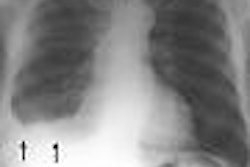For most physicians, just sitting in on a real-life malpractice trial would be worthy of an episode of "Fear Factor." A mock trial of a malpractice case, on the other hand, could be more exciting than bungee jumping off McCormick Place, and far more educational. For the first time, the Radiological Society of North America (RSNA) will put on a medical-legal jury trial at the 2004 meeting, complete with a judge, lawyers, expert witnesses, and a regular-Joe jury.
The trial will take place on November 28 from 10:30 a.m. to 3:30 p.m. in the South Building Grand Ballroom (S100AB) at McCormick Place. The fictional case will involve a 60-year-old family man who presented to his physician with a cough. His chest x-ray was read as normal by the radiologist. Ten months later, the man was diagnosed with late-stage cancer and died, leaving behind a wife and four children. The radiologist stands accused of missing the lung lesion on the original film and breaching the standard of care.
The real-world legal eagles in this mini courtroom drama will be Judge Stuart Nudelman from Cook County Circuit Court; attorney Timothy Nickels from the firm Swanson, Martin & Bell for the defense; and attorney Keith Hebeisen from Clifford Law Offices for the plaintiff. All are based in Chicago.
On the medical side, Dr. Ruth Ramsey from Chicago-based Premier Health Imaging will play the defending radiologist. Dr. Leonard Berlin from Rush North Shore Medical Center in Skokie, IL, will act as expert witness for the plaintiff, while Dr. Lawrence Muroff will serve as the expert witness for the defense. Muroff is from the University of Florida in Gainesville and the University of South Florida College of Medicine in Tampa.
Finally, volunteers from the McCormick Place staff will make up the jury. And unlike a real trial, once the verdict has been delivered, the audience will have the chance to ask the jury members "What were you thinking?"
"We'll ask a couple of jurors to explain to the audience how they perceived the evidence as laypeople," said Berlin, who is coordinating the session. "That's what's really unique. We are going to get a layperson's perspective and the extent to which sympathy for the widow influenced their decision."
Of course, this trial will move along much faster than it would in the real world. Opening arguments and testimony will be given before lunch, during which time the jury will deliberate. The closing statements, verdict, and question-and-answer period will resume in the afternoon.
Berlin acknowledged that catching the entire trial may not be possible for many RSNA attendees, and invited them to come and go at their convenience. But besides the Q&A with the jury, other elements that will be worth sticking around for include expert testimony from two medical oncologists, a discussion with the judge about how the case played out, and a discourse from the attorneys on their respective strategies.
While the trial is loosely scripted, the players will have to think on their feet as the events unfold. One issue that Berlin said he believes will be of great interest to the audience is where sympathies lie in these types of cases.
"There is a perception by all of us on the medical side that there is a sympathy factor. Of course, the plaintiff's lawyer will say there isn't. But will the jury feel sorry for the woman? Will they be biased? We're going to find that out," Berlin said.
Other medico-legal sessions at the 2004 RSNA include:
- "Malpractice Lawsuits: What Gets You in and What Keeps You out of Them -- What Is Their Economic Impact, and Is There Any Light at the End of the Tunnel?" Drs. Leonard and Jonathan Berlin, Refresher Course (RC) 227.
- "Self-referral in Imaging: Scope of the Problem and Possible Remedies," Drs. Alan Kaye and David Levin, RC 327.
- "Protecting Assets from Creditor Claims, Including Malpractice," Barry Rubenstein, Plenary Sessions (PS) 01.
- "The Causes of Malpractice Suits in Radiology: The Contemporary Records of 5,300 Radiologists," Drs. Shantie Harkisoon and Stephen Baker, Scientific Paper SSK23-07.
- "Securing Our Future by Appropriate Risk Management," Dr. Lawrence Lau, PS SFF03.
- "Will JCAHO's National Patient Safety Goals Make a Difference in the Way You Practice?" Paulette Snoby, RC 424.
- "Patient Safety in Radiology: Using Information Technology to Reduce Radiologic Errors," RC 516.
By Shalmali Pal
AuntMinnie.com staff writer
September 29, 2004
Related Reading
Court allows suit over radiologist's findings in pre-employment x-ray, August 20, 2004
Malpractice and mammography: An exam oversold? July 15, 2004
California law shrinks malpractice payouts - study, July 13, 2004
Copyright © 2004 AuntMinnie.com



















